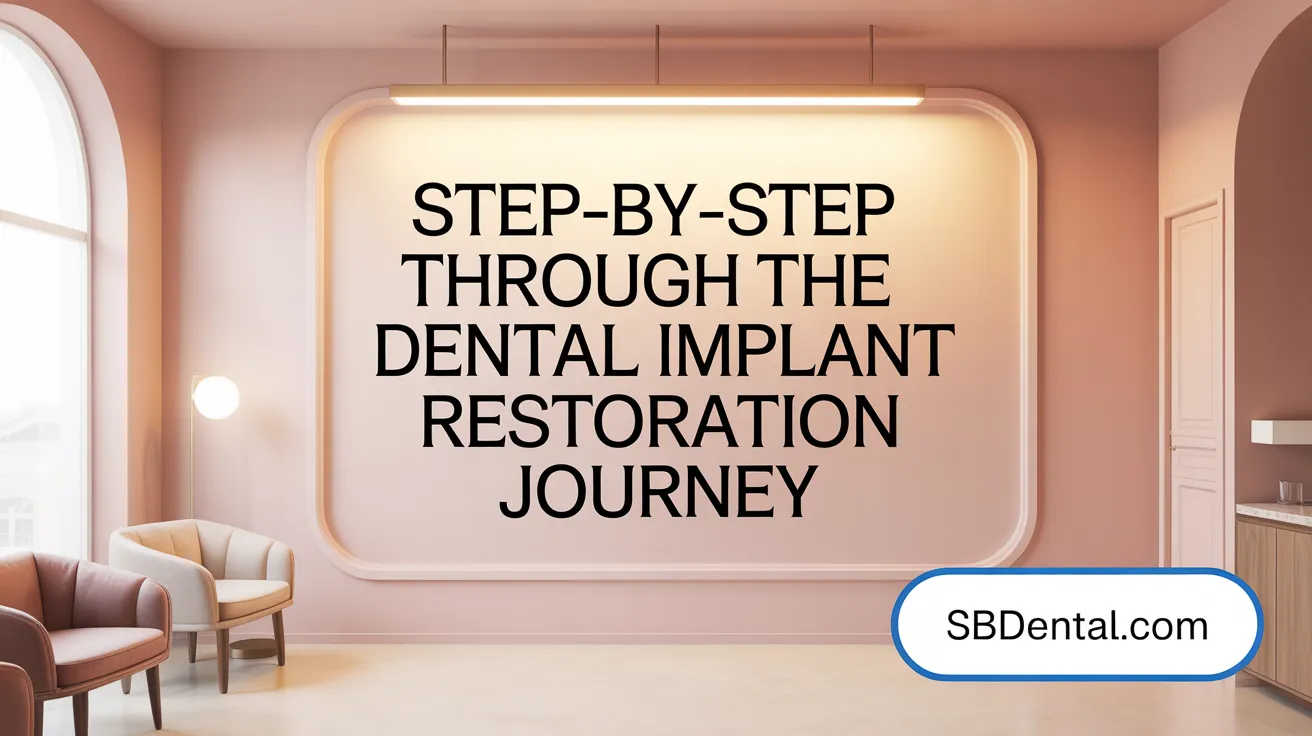Introduction to Dental Implant Restoration
Dental implant restoration is a transformative dental procedure designed to replace missing teeth with durable, natural-looking, and functional substitutes. This process not only enhances aesthetics but also restores chewing ability, supports facial structure, and preserves jawbone health. Patients considering dental implants often seek to understand what the process entails—from initial consultation through final restoration and healing periods. This article explores the stages, surgical details, recovery expectations, types of restorations, and care essentials involved in dental implant restoration to guide patients on what to expect.
The Dental Implant Restoration Process: Key Stages and Components

What is the dental implant restoration process, and what are its main stages?
The dental implant restoration process is a comprehensive procedure that replaces missing or damaged teeth with artificial ones supported by implants. It involves several critical phases to ensure the result is both functional and natural-looking.
Initially, patients undergo a consultation for dental implants that includes dental and medical evaluations, imaging such as Dental X-rays for Implant Assessment or CT scans, and treatment planning. If necessary, preparatory procedures like Bone Graft Procedures or sinus lifts are performed to ensure sufficient support for the implant.
The core of the process is implant surgery, where a Titanium Post Placement is surgically inserted into the jawbone. This post acts as a root for the new tooth and is designed to fuse with the bone during a process called osseointegration, which takes several months.
Once the implant has securely fused with the jawbone, a second minor surgery attaches an Abutment Attachment to the implant. The abutment serves as a connector between the implant and the final restoration.
Finally, a custom-made prosthetic—such as Prosthetic Crowns for a single tooth, Dental Bridges for multiple teeth, or Dental Dentures—is fabricated based on impressions of the mouth and attached to the abutment. This restores the appearance and function of a natural tooth.
Throughout the process, proper aftercare, including Oral Care for Implants such as diligent oral hygiene and Regular Dental Checkups, is vital. With proper maintenance, a dental implant can last over 25 years, providing a Long-Lasting Dental Implants solution for missing teeth.
Surgical Procedure and Healing: What Happens During and After Implant Placement

Steps of implant surgery
The process begins with administering local anesthesia to numb the area. An incision is made in the gum tissue to expose the jawbone. A pilot hole is carefully drilled into the bone to create a space for the implant. Then, a titanium post—serving as the root of the new tooth—is inserted into this prepared site. The gum tissue is sutured to cover the implant, which helps protect the site. This minor surgery may involve additional procedures like bone grafting if there is not enough natural bone to support the implant.
Use of local anesthesia and sedation
Local anesthesia is standard to ensure the patient remains comfortable and pain-free during the procedure. In some cases, sedation options such as intravenous sedation or nitrous oxide may be offered for anxiety management or more complex cases, providing a deeper level of comfort.
Incision and implant drilling
Initially, an incision is made in the gum tissue to access the jawbone. The surgeon then drills a small pilot hole, followed by progressively larger holes to prepare the bone for the implant. Precision is crucial here to avoid damaging surrounding structures and to ensure the implant fits securely.
Titanium implant insertion
The titanium implant is carefully screwed or tapped into the prepared hole. Titanium is used because it fuses well with bone through a process called osseointegration, which makes the implant stable and durable. After placement, the gum tissue is closed with sutures, and the site begins the healing process.
Suturing and minor surgery nature
The procedure is typically minimally invasive, often performed on an outpatient basis. The sutures help hold the gum tissue firmly in place and protect the surgical site. Patients usually experience mild discomfort afterward, similar to other minor surgical procedures.
Osseointegration process
Osseointegration is the critical phase where bone cells grow and bond around the titanium post, anchoring the implant securely in the jaw. This process can take between 3 to 6 months depending on individual healing rates and bone quality. During this time, the implant integrates with the bone, providing a stable foundation for the final prosthetic.
Healing timeline and recovery phases
Initially, patients will experience swelling, mild bruising, and discomfort, which are manageable with medications and iced compresses (postoperative care). The first week is the most uncomfortable, but pain and swelling decrease progressively. Full recovery, including osseointegration, spans several months. Patients must follow post-operative care instructions carefully, including maintaining good oral hygiene and avoiding hard or sticky foods.
Postoperative symptoms and management
Common symptoms include mild swelling, bruising, and slight bleeding. Pain is usually mild and can be alleviated with over-the-counter pain relievers (pain management tips). Patients are advised to rest, avoid strenuous activities, and keep hydrated. Smoking should be avoided because it impairs healing. Regular follow-up visits ensure proper healing and monitor the integration of the implant, setting the stage for the placement of the final restoration.
Post-Operative Care and Managing Recovery for Successful Implant Integration
What post-operative care and tips can aid healthy healing following dental implant surgery?
After dental implant surgery, diligent care is crucial for proper healing and successful integration of the implant. Patients should follow their dentist's instructions closely, which typically include maintaining excellent oral hygiene with gentle brushing near the surgical site, using prescribed antimicrobial rinses like chlorhexidine to reduce bacteria, and avoiding rinsing or spitting aggressively for the first 24 hours. Eating a soft, balanced diet is recommended for at least 2-4 days post-surgery, steering clear of hot, spicy, sticky, or hard foods that could irritate the site.
Applying cold compresses during the first 48 hours helps minimize swelling, followed by warm compresses to promote blood flow and healing. Patients should elevate their head while resting to reduce swelling and sleep with an extra pillow. Pain management involves taking prescribed medications with food, and completing any antibiotics prescribed by the clinician is essential to prevent infection.
Attending all follow-up appointments allows the dentist to monitor healing and address any issues early. Avoiding smoking, alcohol, and strenuous activities during the initial healing phase supports optimal osseointegration process, which typically takes between 3 and 6 months.
What common issues or side effects might patients experience during the dental implant recovery phase?
Common side effects during recovery include swelling, mild to moderate pain, bruising, and minor bleeding. Swelling often peaks within the first 2-3 days and can be reduced with ice packs and anti-inflammatory medications. Discomfort can usually be managed with over-the-counter or prescribed painkillers.
Infection is also a risk, especially if oral hygiene is poor or bacteria enter the surgical site. Signs of infection include increased swelling, persistent pain, fever, or pus discharge. Sensory disturbances, such as numbness or tingling, may occur if nerves are affected during surgery but usually resolve with time.
Rarely, more serious complications like hematomas, nerve injuries, or sinus issues may develop, necessitating prompt medical intervention. Maintaining proper hygiene, adhering to medication regimens, and avoiding irritants like smoking and alcohol are essential to minimize these risks and promote smooth healing. For detailed guidance on post-implant healing care, patients should consult their dental professionals.
Dental Restorations and Their Roles in Implant Procedures

What types of dental restorations are used in implant procedures, and what roles do they serve?
In dental implant procedures, the choice of restoration depends on the number of missing teeth and the specific needs of the patient. Among the most common restorations are single crowns, bridges, and full-mouth prostheses, each designed to restore function, appearance, and oral health.
Single tooth restorations typically involve a titanium implant topped with a custom porcelain or zirconia crown. This mimics a natural tooth, restoring biting and aesthetic qualities.
For replacing multiple adjacent teeth, implant-supported bridges are employed. These bridges anchor onto two or more implants, providing a stable and durable solution while preventing bone deterioration in the jaw.
In cases of extensive tooth loss, full-arch restorations such as implant-supported dentures or All-On-4 implants are used. These are often made from materials like acrylic or zirconia and provide a fixed, natural-looking set of teeth for the entire upper or lower jaw.
The materials used in these restorations, including porcelain, zirconia, and acrylic, are chosen for their durability and aesthetic properties, closely resembling natural teeth.
How are dental restorations fitted and customized?
Restorations are meticulously crafted based on detailed impressions and bite registrations to ensure perfect fit and function. Modern CAD/CAM technology allows for precise customization.
What are the options for crown attachment, and what are their pros and cons?
Crown attachments can be either cemented or screw-retained. Cemented crowns offer superior aesthetics but are less easily retrievable, making maintenance more challenging. Screw-retained crowns are easier to remove for repairs or examinations and typically involved in cases where retrievability is a priority.
How do restoration choices vary with the number of missing teeth?
Single tooth loss generally involves a crown directly mounted on a single implant. Multiple missing teeth may require bridges supported by multiple implants, while extensive loss involves full arch prostheses. These options provide scalable solutions tailored to each patient's needs, ensuring a functional, stable, and natural-looking result.
Importance, Benefits, and Influencing Factors for Successful Dental Implant Restoration

Why is dental implant restoration important, and what are its benefits?
Dental implant restoration is essential because it provides a reliable and natural-looking solution for missing teeth. It restores proper chewing ability, supports clear speech, and maintains facial aesthetics by preserving the jawbone and facial structure. Implants promote jawbone health through osseointegration, preventing bone deterioration and facial sagging.
These restorations mimic natural teeth both in appearance and function, which helps boost confidence and self-esteem. They are designed to be durable and stable, often lasting over 25 years when properly cared for, making them a cost-effective long-term solution. Unlike removable dentures, implants do not affect adjacent teeth and contribute to overall oral health, reducing the risk of further dental issues.
Long-term durability, aesthetic appeal, and preservation of oral structures are among the main advantages, making implant restoration a vital part of comprehensive dental care.
What general factors influence the success and process of dental implant restoration?
The success of dental implant restoration depends on several critical factors. Patient health plays a significant role, including overall systemic conditions such as diabetes, osteoporosis, or vitamin deficiencies that may impair healing. Lifestyle habits like smoking or poor oral hygiene can hinder osseointegration and increase the risk of implant failure.
Surgical factors, such as the type of implant used, precise placement guided by advanced imaging, and proper surgical technique, are vital for a successful outcome. The prosthetic part, whether a crown, bridge, or denture, must be correctly designed and fitted to function optimally.
Bone quality and quantity are crucial; inadequate support may require additional procedures like bone grafting or sinus lifts to ensure stability.
Patient compliance with post-operative guidelines, regular dental check-ups, and diligent oral hygiene help prevent complications like peri-implantitis and bone loss. An experienced dental surgeon and a proactive patient are essential for high implant survival rates and long-lasting results.
| Factors | Impact on Success | Additional Notes |
|---|---|---|
| Overall health | Critical for healing | Systemic conditions affect osseointegration reliability |
| Smoking habits | Increases failure risk | Smoking impairs healing, promotes infection |
| Bone support | Essential for stability | Bone grafts may be needed if support is insufficient |
| Surgical precision | Ensures proper placement | Use of imaging technology improves outcomes |
| Post-op care and maintenance | Maintains long-term success | Regular check-ups prevent complications |
| Expertise of clinician | Improves treatment success | Skilled practitioners reduce risks of failures |
This collective understanding highlights that successful dental implant restoration depends on a combination of careful planning, surgical skill, patient health, and good maintenance practices, ultimately ensuring a durable, functional, and attractive result.
Final Thoughts on Dental Implant Restoration
Dental implant restoration is a multi-step process that demands careful planning, surgical precision, patient commitment, and meticulous aftercare. Understanding what to expect—from surgical placement and the crucial healing and osseointegration period, to the final fitting of crowns or dentures—empowers patients to approach treatment confidently. The benefits of restoring function, aesthetics, and oral health are significant, contributing to improved quality of life. With advances in dental technology and experienced clinicians, dental implants offer a long-lasting, natural solution for missing teeth, fostering renewed smiles and lasting oral wellness.
